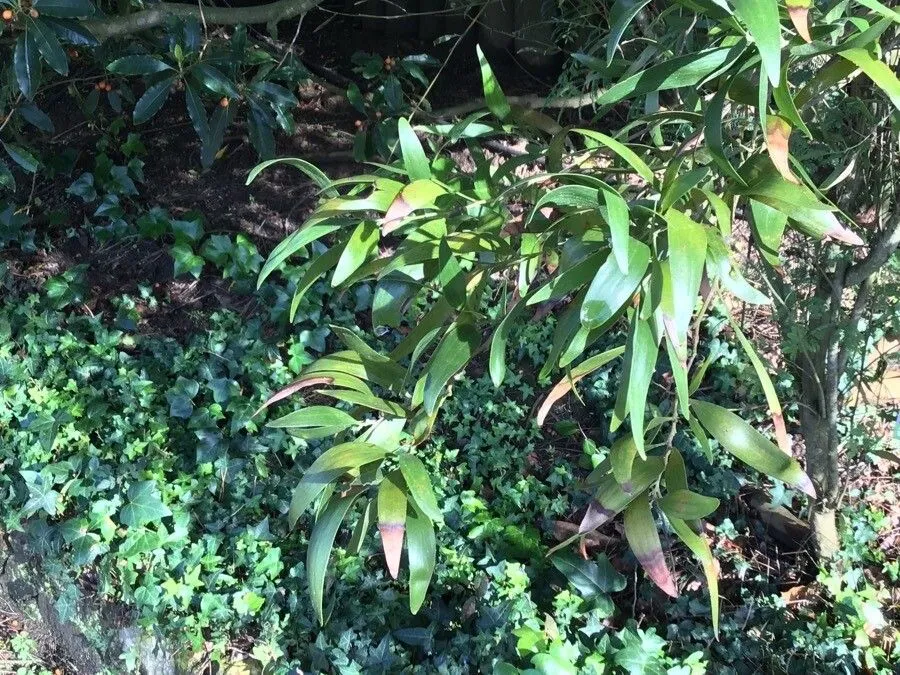
Author: (Labill.) H.L.Wendl.
Bibliography: Comm. Acac. Aphyll.: 26 (1820)
Year: 1820
Status: accepted
Rank: species
Genus: Acacia
Vegetable: Unknown
Observations: SW. Australia
The Orange wattle, scientifically known as Acacia saligna, is a remarkable species within the Fabaceae family. First documented in 1820 through the efforts compiled in “Comm. Acac. Aphyll.: 26”, this plant’s nomenclature was credited to the naturalist Labill. and later expanded upon by H.L. Wendl.
Native to Southwestern Australia, the Orange wattle thrives in its endemic environment, adeptly showcasing its hardiness and adaptability. Acacia saligna is recognized for its vibrant yellow blooms, which grace the landscape with a splash of color, typically during the spring season. This perennial shrub or small tree is well-regarded not only for its aesthetic appeal but also for its resilience in relatively arid conditions.
Acacia saligna has become an important species in re-vegetation and soil stabilization projects, owing to its fast-growing nature and robust root system. Its adaptability to a variety of soil types and environmental conditions makes it a valuable asset in ecological restoration efforts. In areas prone to erosion or degraded landscapes, the Orange wattle plays a crucial role in rehabilitating the land and fostering biodiversity.
The leaves of Acacia saligna are actually phyllodes, which are modified leaf stems that serve the same function as typical leaves. These phyllodes are long, slender, and rich green in color, providing a dense canopy that offers shelter and sustenance to a myriad of wildlife.
Despite its many benefits, Acacia saligna’s introduction to areas outside its native habitat should be approached with caution due to its potential to become invasive. Proper management and monitoring are essential to ensure that its spread does not disrupt local ecosystems.
In summary, the Orange wattle, Acacia saligna, stands out as a plant of significant ecological and ornamental value. Originating from the diverse landscapes of Southwestern Australia, it continues to be a species of interest for both conservationists and horticulturists around the world.
Ita: acacia saligna, gaggia, mimosa
Fra: mimosa bleuâtre, mimosa orange
Eng: orange wattle, port jackson wattle, port jackson-willow, western australian golden wattle, blue-leaf wattle, golden-wreath wattle, silver wattle, weeping wattle, willow wattle
Heb: shita k’chalchala, שיטה כחלחלה
Dan: tåre-akacie
Deu: weidenblatt-akazie
Spa: acacia, mimosa
Por: acácia
Ell: akakia, kyanofylli akakia
Swe: blåakacia, tårakacia
En: Orange wattle, Port Jackson wattle, Port Jackson-willow, Western Australian golden wattle, Blue-leaf wattle, Golden-wreath wattle, Silver wattle, Weeping wattle, Willow wattle
Af: Port Jackson
Ca: Acàcia de fulla blavenca
Zh: 傑克遜港楊柳, 柳叶相思
Da: Tåre-akacie
Fr: Mimosa bleuâtre, Mimosa orange
De: Weidenblatt-Akazie
El: Akakia, Kyanofylli akakia
He: שיטה כחלחלה, Shita k’chalchala
It: Acacia saligna, Gaggia, Mimosa
Fa: اقاقیا سالیگنا
Pt: Acácia
Ru: Акация ивовая
Es: Acacia, Mimosa
Sv: Tårakacia, Blåakacia
Zh-hant: 柳葉相思
Tr: Kıbrıs akasyası
Taken Jan 16, 2021 by Diego Alex (cc-by-sa)
Taken Jul 3, 2022 by Anatas (cc-by-sa)
Taken Jun 20, 2022 by Sarpa Rilem (cc-by-sa)
Taken Sep 4, 2020 by Mark Jackson (cc-by-sa)
Taken Sep 4, 2020 by Mark Jackson (cc-by-sa)
Taken Apr 6, 2021 by Giuseppe tedesco (cc-by-sa)
Taken Feb 17, 2022 by Rainer Höchsmann (cc-by-sa)
Taken Sep 4, 2020 by Mark Jackson (cc-by-sa)
Taken Mar 3, 2021 by Lotta Eriksson (cc-by-sa)
Taken Jul 3, 2019 by beth beth (cc-by-sa)
Taken Mar 3, 2021 by Lotta Eriksson (cc-by-sa)
Taken Apr 9, 2021 by Hacer (cc-by-sa)
Taken Feb 22, 2020 by Linda Veugen (cc-by-sa)
Taken Mar 2, 2021 by Reinhold Karls (cc-by-sa)
Taken Apr 6, 2021 by Giuseppe tedesco (cc-by-sa)
© copyright of the Board of Trustees of the Royal Botanic Gardens, Kew.
© copyright of the Board of Trustees of the Royal Botanic Gardens, Kew.
© copyright of the Board of Trustees of the Royal Botanic Gardens, Kew.
Taken Apr 18, 2015 by Daniel Barthelemy (cc-by-nc)
Taken Apr 18, 2015 by Daniel Barthelemy (cc-by-nc)
Taken Apr 5, 2022 by Flóra Hajdú (cc-by-sa)
Taken Mar 17, 2021 by Manuel Hernández (cc-by-sa)
Taken Oct 18, 2021 by Canca (cc-by-sa)
Taken Oct 25, 2021 by sandro.todeschini todeschini (cc-by-sa)
Taken Oct 17, 2020 by Ortiz Claudia (cc-by-sa)
Taken Feb 11, 2020 by Viviane Rezzoug (cc-by-sa)
Taken Jan 31, 2021 by Pablo (cc-by-sa)
Taken Mar 30, 2021 by M. ivi (cc-by-sa)
Taken Apr 18, 2021 by Fregenal Mary Lola (cc-by-sa)
Taken Jun 20, 2022 by Sarpa Rilem (cc-by-sa)
Taken Sep 18, 2019 by Dieter Albrecht (cc-by-sa)
Taken Nov 22, 2020 by mario peters (cc-by-sa)
Family: Myrtaceae Author: (F.Muell.) K.D.Hill & L.A.S.Johnson Bibliography: Telopea 6: 402 (1995) Year: 1995 Status:…
Family: Rubiaceae Author: Pierre ex A.Froehner Bibliography: Notizbl. Bot. Gart. Berlin-Dahlem 1: 237 (1897) Year:…
Family: Sapindaceae Author: Koidz. Bibliography: J. Coll. Sci. Imp. Univ. Tokyo 32(1): 38 (1911) Year:…
Family: Asteraceae Author: A.Gray Bibliography: Pacif. Railr. Rep.: 107 (1857) Year: 1857 Status: accepted Rank:…
Family: Fabaceae Author: Medik. Bibliography: Vorles. Churpfälz. Phys.-Ökon. Ges. 2: 398 (1787) Year: 1787 Status:…
Family: Aspleniaceae Author: (Cav.) Alston Bibliography: Bull. Misc. Inform. Kew 1932: 309 (1932) Year: 1932…